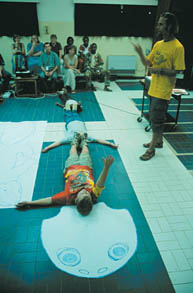Extreme Research (Page 3)

Larsson gives a presentation to school kids in Niamey, Niger.
Larsson's most recent trip to Niger was last year, when he co-led a dig that revealed three new species of carnivorous amphibians and two new herbivorous reptiles. Like the Arctic, Niger imposes considerable challenges on researchers; the forms they assume, however, are polar opposites. Instead of bone-chilling cold, of course, there is the withering heat. The unnerving isolation is replaced by the sinister presence of people.
"I really feel safer around polar bears because they're predictable, at least," he says with an ease that might come more readily in retrospect than at the time.
His first trip to Niger, in 1993, coincided with the tapering off of a civil war. Subsequently, in 1997, 2000 and 2003, he has found that the rebel forces have simply evolved into bandits. Out in the hinterland, armed guards are an absolute must to deter the bandits from attacking and stealing the expedition's coveted equipment and provisions.
"During one small window when we didn't have guards, bandits swooped in and stole our vehicles, cash and other equipment," he recalls. "But we're learning more as we go along. We have a better sense of how many guards we need, and what political groups we have to talk to in order to facilitate things. Being the second poorest country in the world, it's kind of hard for people there to sustain interest in what we're doing, but over the time that we've been in Niger, the government and the university have become more interested in our work, and that's helped."
Starting Young
Larsson traces his fascination with dinosaurs back to when he was five and would collect shells and fossil snails from the shores of Lake Ontario, where he grew up. He would also gather whatever roadkill he found, bringing it home for close inspection of the unfortunate animal's anatomy, much to his parents' chagrin. Such obsessions aren't at all unusual in young children. Sustaining the passion through years of under- and post-graduate study, however, is.
"I just found it too exciting to ever give it up," Larsson, now 33, laughs.
Arrayed just outside his Redpath Museum office is a collection of bones and fossils from the pioneering days of Sir William Dawson, the great Victorian polymath and McGill principal who had a deep interest in paleontology. That McGill is home to the oldest natural history museum in Canada and is one of barely a handful of universities to host a functioning museum, was a significant feature that attracted him to return to the university where he earned his undergraduate degree. The museum is largely responsible for McGill's reputation in the field and contributes greatly to its ability to bring in promising students.
What made Larsson so attractive to McGill when the University was looking for a paleontologist to replace the retiring Professor Robert Carroll, Redpath's vertebrate curator, was his unique skill sets, combining paleontology with developmental embryology.
"What struck me in observing his graduate study was his work in evolutionary developmental biology," claims Carroll, who assumed emeritus status in 2003 following more than 40 years of teaching and research at the University. "This research promises to open a window on a whole range of new characteristics to allow us to better understand the process of evolution."
Prior to the recent enhancement of the science of genetics, the evolution of fauna was studied primarily through skeletal structures: that is to say, bones. Examining the genetics of evolution allows scientists to catch a glimpse of the building blocks underlying the entire process that Darwin elucidated through observation and succeeding generations have elaborated through a variety of experimental pursuits.


